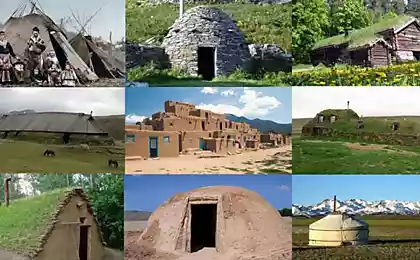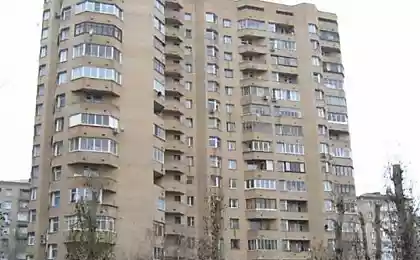700
Where to build a house: the wisdom of our ancestors

© Ilya Repin. Abramtsevo.
Observations of our ancestors helped them to determine exactly where to live is easy and secure.
"Where the dog went, says one of the Proverbs, to build a house...
where forty of the village of Roy well"
Dog react to a bad area, the deterioration of health. Even in the wild cold the dog would not be lying in a kennel if the kennel is above the fold.
With Jay, too, everything is easily explained: it looks for insects, and they prefer gepatogenna areas usually wet.
Modern scientists in numerous studies have found that these observations are correct. Here are some facts.
Cows living in sheds located on gepatogenna areas, are more likely to develop leukemia, they found a malignant tumor, they suffered a malfunction of the internal organs and gave birth to viable calves.
Chickens and ducks over the areas lost tail, poorly swept, their offspring suffered from genetic diseases.
The people who settled in bad places, too, responded to the area negative: they found cardiovascular diseases, cancer, mental disorders, birth defects.
During examination of patients in hospitals located on the ill-fated portions of the earth, found that the mortality in the wards that are located over the faults, much higher than in those where the electromagnetic radiation has a stable value.
And the percentage of cancer in those living above the faults sometimes three to four times higher than those living far from such.
But, you say, people in the old days knew nothing about the inhomogeneity of the magnetic radiation of the Earth. I didn't, but saw something reflected (i.e. availability zone) on the life of animals, man.
They explain this by the evil spirits, the evil eye, a manifestation of the dark forces.
But whatever you call the phenomenon what reason nor think, facts were facts. And they just showed that the energy at the break is broken, to live there. That's why houses were not built.
The farmer picks the construction of a new home, carefully examined the district: if not found in a large number of snakes, ants, bees, whether on the site of the stagnant water with frogs and leeches, a lot of dragonflies, insectivorous birds.
Insects and reptiles of the great transfer of pulsed radiation, they choose areas for breeding and wintering, ants build anthills.
Sometimes I checked the site for the future home a very simple way: transferred to him the ant hill and watched how to behave like ants: if you start a mass Exodus – that's great, if you will – better homes not to build.
Sometimes put a hive of bees. Those, too, are sensitive to zones: if bees feel good, the house did not put there.
Note that all apiaries are located away from residential buildings, usually they are out of the village, and all because bees are also very fond of the zone, and in a normal country they don't like to live.
Another farmer taking a look around, what herbs, flowers, trees grow in the area. Linden, maple, pine – good. Oak, willow, alder, bad.
In the old days the conclusions were based on long observations and experience of several generations, but then the scientists explained why one of the plants of grace to live in the area and the other in her feel bad.
It is in the degree of capacity of the root system. Plants for a normal life need water, some of them water-loving, others are drought-resistant.
Moisture-loving species for life you need to be sure there was a powerful underground aquifer. This layer is formed in areas of breaks or cracks when underground voids are filled with groundwater.
Here at bad places and grow water – loving trees- willow, aspen, alder, oak, elm, ash.
Conifers, basswood and birch zones are avoided, or are they quickly waste away...
Similarly, the determined area and for the grasses: all marsh grass prefer is bad for human space. Sedge, Ledum, Hypericum, wormwood, for example, avoid dry soils.
In the old days people knew what kind of vegetation grows on dry land, and which tend to moisture.
They very carefully chose where to build the House.
Ethnographers have documented numerous magical rituals and beliefs associated with building a house in the Eastern Slavs.
The spell action has already started when choosing a site for future housing. According to the ethnographer Vladimir Bogdanov, the Belarusians in the middle of the XIX century consecrated selected for Wilby as: for all the supposed site of the manor is the bar on the ground, a large square; it was divided crosswise the figure into four parts. Then the head of the family went to "all four sides" and brought in four fields the four stones were placed in the centers of small squares. As a result, the future site of the manor there was an ideogram of fertility, which is known since the bronze age and until the Russian wedding embroideries of the early XX century
For the construction of a hut out in the forest special trees that are related to the category of "violent" or "stupid". The tab structure should begin, "when brimming with a month", that is, after the new moon.
Under the corners of the first crown of logs laid with magical purpose: a piece of wool, a handful of grain, incense, wax. Archaeological materials testify to the fact that sometimes under the corner of the house put a horse's head. It is possible that this ancient custom Russian fairy tale about a girl-seven years, the orphan, seeking the advice of a "Mare's head". However, the story could occur under the influence of faith in the magical power of "Konika" (from the word "con" — "the beginning", "basis") the sacred furnace post that often in consonance with the name of the horse was given the shape of a horse's head.
A special ritual actions were accompanied by the strengthening beams (svoloch), which lay the ceiling ("STEL"): it was fastened inside-out fur coat (an echo of the cult of the bear?) and a loaf of bread, a cake or a pot of porridge. At the same time from the upper crown of a log house with all sorts of good wishes were scattered from the grain and hops. The joist is often cut, "thunder sign" wheel of Jupiter with six spokes.
After completion of construction, a feast was arranged; if the house was built "cleanup", that is, with the help of relatives and neighbors, the participants solemnly fed after each stage of construction. The earliest family in the new house was accompanied by the rite of transferring of the fire from the old housing and relocation of houses from the old to the new podpeca. Brownie asked and invited: "Brownie, brownie! Come with me!" Or master, standing at the gate, and bowing on three sides, cried out: "Father house and mother house, the yard father and mother yard with the entire family, come join us for a new home to live with us!" Brownie was transported in the pot with the heat from the old furnace to the grain shovel.
Inside the house, there have been a number of pagan festivals.It's not just about uzcasemash matters like matchmaking, weddings, funerals. Almost all amdeselassie and crowded as a tribal "councils" and "events" were carried out in two plans: some part of the ceremony was done in squares, shrines and Treviso, and which every family in his heromine, your furnace, your horse.
Christmas divination and spell the next harvest, carols and wedrowki, masquerades, bear comodity, riotous Shrovetide feasts of pancakes, rituals associated with the first pasture of cattle, the remembrance of deceased ancestors, celebrating the harvest and much more — it all began in every family, inside the house where the head of the family ("Prince" in wedding parlance) performed the functions of priest and oversaw the festive ceremonials.
The second stage after household rites was the imposition of the festivities outside, in the common "secular Assembly"; the house remained the point where he started and where he ended every pagan rite, whatever the scale it takes at the moment of climax. No wonder the phrase "home" has acquired a stable social meaning. Medieval heretics strigolniki, rejected the monopoly of the Church on religious activities, relied on the ancient and sustainable Slavic tradition, claiming that "my house — my temple". published
P. S. And remember, only by changing their consumption — together we change the world! ©
Source: vk.com/vselo
How to grow tomato tree in a barrel
Way of life-style sharing economy, or how Amsterdam became the world capital of life chipped























